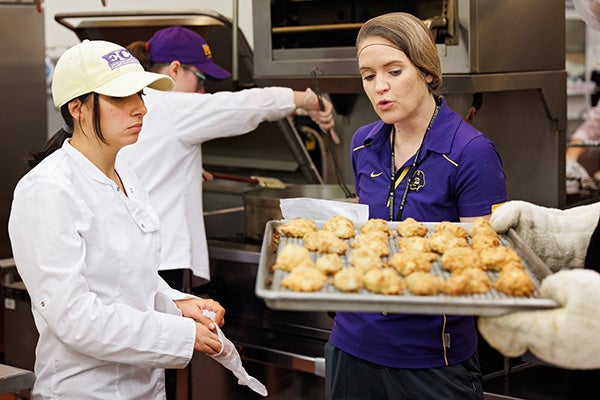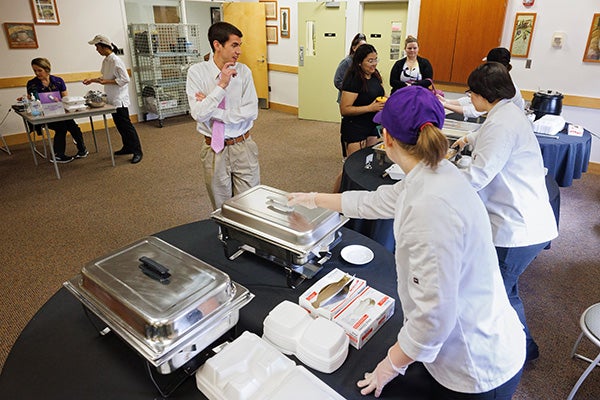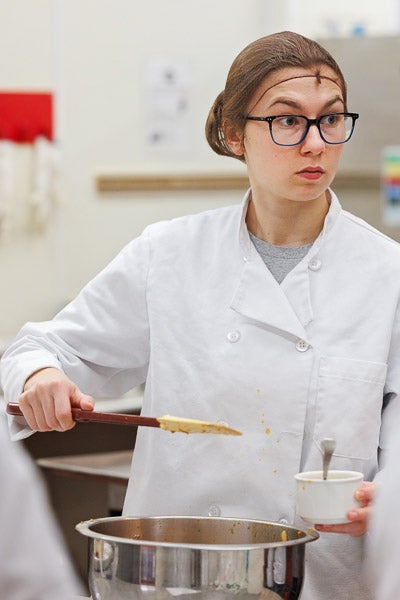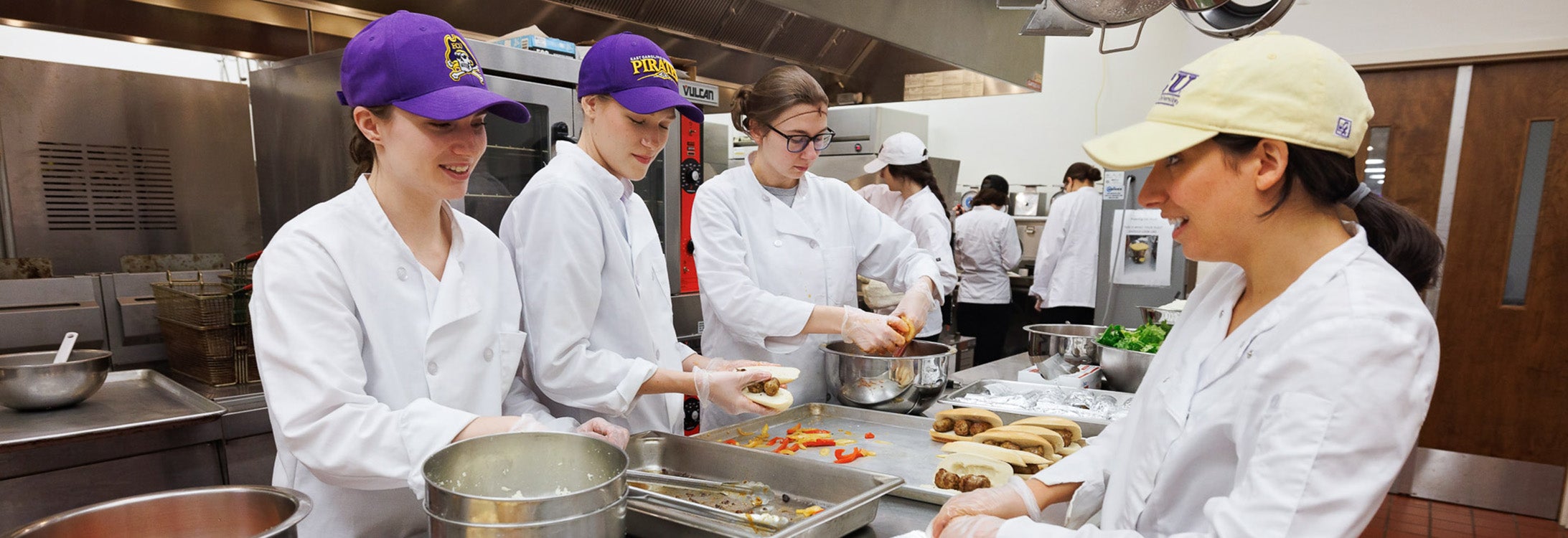HANDS-ON NUTRITION
Nutrition science students scale up food production to nourish the campus community
Food makes life richer, more enjoyable. It solidifies culture and fosters unshakable foundations for families. Food assists with super-human endurance and strength or can destroy a body’s ability to sustain life.
Knowing how to tie together the science of chemistry, the art of cooking and the love needed to help heal the sick is the mission of the Department of Nutrition Science at East Carolina University’s College of Allied Health Sciences.

Roxanne Wilder, right, discusses food preparation techniques with nutrition sciences students in the commercial kitchen in the Rivers building.
The nutrition science department is typical in that the faculty and staff train and educate the next generation of registered dietitians and nutrition science professionals. The program stands out because the food that students create in the Quantity Food Lab is sold to customers across campus, which provides a great real-world opportunity for students to learn menu planning and food production principles, as well as the fundamentals of financial sustainability.
The program
ECU’s nutrition students follow two main tracks: the Didactic Program in Dietetics (DPD), which produces graduates who pursue certification as a registered dietitian; and the Nutrition with Science major, which primarily provides pre-professional training for students who continue on to health science graduate programs like physical therapy, dentistry and medicine.
The DPD requires the traditional undergraduate four years of study, but then students spend a year in an unpaid internship before being able to sit for the test that confers the registered dietitian qualification.
Roxanne Wilder, a clinical instructor with the College of Allied Health Sciences, teaches the quantity foods course, which introduces students to the skills necessary to manage food production in a commercial kitchen. Wilder said that by 2024, the Commission on Dietetic Registration will require students who intend to take the registration examination for dietitians to have a master’s degree in dietetics or a health-related field like public health, which is changing the trajectory for current students and those applying to begin coursework as juniors in fall 2024.
Wilder, who graduated from the ECU nutrition program in 2011, said enrollments for the master’s program are expected to increase with the new credentialling requirements.
Regardless of the career path, every student in the Didactic Program in Dietetics must complete the quantity foods preparation course. Students may end up working in clinical settings, like hospitals and long-term care facilities, or in community roles with nutrition counseling in local health department or private practice, but all must understand how food is prepared in bulk.
If a dietitian doesn’t understand the basics of commercial food production, then how can they expect to direct the cooking they recommend to full-time kitchen staff who have years of experience translating menus into healthful food?
“In the fall we have a lecture course where they learn the textbook aspects and complete projects like developing a menu that meets specific nutritional needs of a population,” Wilder said. “And then in the spring semester we prepare those menus in the kitchen.”
Part of the process of transitioning a recipe from a beloved cookbook to a commercial kitchen is knowing how to order from commercial suppliers and scaling up a recipe designed for a family of four. With some guardrails in place, Wilder lets her students sink or swim with their menus to instill a sense of responsibility to the process.
“Once they have their recipes completed, they put together a market order. They are responsible for understanding our vendor-based website and how the food is sold on those websites, the pack sizes and how to cost out those recipes,” Wilder said. “Whether or not we have something in lab for their menu is all on them. I look over it obviously, but it’s their responsibility to make sure they go through everything with a fine-tooth comb as you would as a manager in any type of institution.”
Oceanna Deal, who is half German and grew up in Germany in a military family, was responsible for the German-themed menu March 16. The Augusta, Georgia, native said that food is a huge part of achieving her weightlifting goals, which naturally lead to studying nutrition more rigorously.
“Not a lot of people do German, a lot of people do Italian,” Deal said. “I’m a little nervous. I don’t like being in charge of people, but I think it’s going well.” The yeast dumplings that Deal selected for the menu, Dampfnudeln and Germknödel — depending on the German-speaking region they are prepared in — were the one item she was most concerned about.
“They’re really complicated, but they are worth it,” Deal said.
And when the cooking is done?
“They also are responsible for washing dishes,” Wilder said. “Food safety is a big component because we serve food to the public and are inspected by health department.”
The students
A body builder. Celiac disease sufferers. Significant weight loss journeys. The common thread connecting the 13 students in Wilder’s spring 2023 class is, of course, food. Most love to be in the kitchen; some have never handled a knife or a tilt skillet. But all have been impacted by how food can make human bodies both sicker and healthier.
Raven Breinholt of Kinston was coring and cutting cabbage for the German-themed meal during the lab. Her sister has celiac disease, which exposed Breinholt to what a dietitian is and does. After high school she volunteered with organizations that work to end nutrition disparities in her community. Her goal after graduation is to continue working with community groups or outpatient nutrition counseling to help address diabetes and other chronic health concerns.
Bryson Gillam, from Salisbury, was charged with making the Black Forest ham sandwiches. He came to the nutrition program after losing more than 100 pounds at age 16.

Nutrition sciences students serve food at the Rivers building.
“Ever since then I’ve had a burning desire for nutrition,” Gillam said.
While he will likely start his post-graduate career in a clinical setting, he has his eyes set on the online meal planning market, similar to the boxed meal subscription services that have taken hold across the country in recent years. A natural entrepreneur, Gilliam could also see himself doing one-on-one virtual counseling to help others use diet to achieve the long-term health goals that he achieved in his teens.
“I love to cook, but we’ve definitely learned a lot more here,” Gillam said.
Each semester Wilder’s students show their flexibility and problem solving, which is a key attribute for nutrition professionals.
This semester her students rearranged the list of printed orders to distinguish which meals stayed on main campus and which had to travel to the health sciences campus, and also reworked the markings on pre-packaged foods in the warmer or refrigerator. These changes may be minor in practice, Wilder said, but they showed the students are constantly making quality improvements, which will benefit them once they are on the job and in charge of a commercial kitchen or in any food production management role.
Regardless of a student’s menu choice or execution of specific cooking skills, Wilder said that she is very proud of each student for trying on new roles and responsibilities.
“In a traditional food service setting you would have a job and that would be the job that you would do day in, day out,” Wilder said. “As soon as they master something, the next week they’re moving on to something else. Seeing them help one another is awesome.”
Sam Stolins, from Wilson, partnered with Cari Jones for the customer-facing aspects of the German food day — organizing the delivery orders for both campuses and assisting with the front-of-house set up.
“When you are in the kitchen it’s Task A and Tack B, chopping and cooking, so this is a little calmer,” Stolins said. “But when it’s time to serve, the pace picks up.”
Stolins has celiac disease, which the Celiac Disease Foundation says is an autoimmune disorder caused by a gluten sensitivity that damages the small intestine. The dietician who helped Stolins gain some measure of control over her condition influenced her decision to get into the nutrition field.
Jones, who is originally from Franklin County, came to ECU for the recreation therapy program but quickly realized that the nutrition program was a better fit. While she job-shadowed a dietitian in high school, the in-the-kitchen part of the nutrition program is new, and fun, for her. Her heart is in bringing an understanding of how nutrition improves the health of the individual, and in turn, whole communities.
“The work I do here now is with underserved communities in rural areas: nutrition and diabetes education, cooking some too, just not to this magnitude,” Jones said.
Jones and Stolins agree that the cooking and macro nutrition parts of their education have been fun and interesting, but the challenge of learning the chemistry and physiology of how food works with the body has been the most surprising.
“All of the science-based stuff, the nutrition and disease class, went really deep into the cellular levels. We learn a lot more than we practice and the scope of everything that we have to know was surprising,” Jones said. “The better that I know the information the easier it is for me to explain it to my patients.”
Scaling up
Wilder said some students enter her class not understanding the importance of knowing how a kitchen works — they want to be dietitians, not chefs. But the end-of-course evaluations are usually very positive.

Nutrition sciences student Morgan Fletcher prepares food during a Quantity Foods Lab at the Rivers Building.
“It’s the spring semester of their senior year so things are crazy. When I get feedback, they all really, really enjoy the class more than they thought they would,” Wilder said. “It gives them time to decompress from sitting in lectures, and even though they’re working hard, they can have conversations with each other about things not related to school.”
The students chomp at the bit each week to get the receipt totals, to see if as a group they had topped the previous week’s sales — a competition with themselves as a way to measure improvement.
Regardless of the menu selected, Wilder oversees the process, from planning to chopping to packaging of to-go meals at a small dining room in the Rivers Building. During the spring 2023 semester, the food sales — about 50 entrees each day — from Wilder’s class have routinely made a profit. Between her time as a student and now an instructor, Wilder said this is the first time in her memory that the program has broken even, which has put faculty and students in the enviable position of figuring out how to offer more healthful food options for the campus community.
Wilder said that the profitability is a perk, but the satisfaction that she ultimately gets is from watching her students learn how a commercial kitchen functions, and watching her students routinely deliver high quality and tasty food, which is key to their futures.
Loretta McDaniel, who works in the administration office at the CAHS, is enthusiastic about having food options on the Health Sciences Campus, which is somewhat of a food desert.
“I look forward to seeing what the ‘experience’ around the world is going to be each week. It is so nice to be able to have a choice of getting something to eat on the health sciences campus as we don’t have any choices unless we want to go off campus to get it. I know it takes a lot of time to plan and prepare, and I appreciate all that the students and the department put into it,” McDaniel said.
Alyssa DeSantis, the CAHS director of alumni affairs, appreciates the opportunity to contribute to student learning, with the added benefit of a nutritious, hot meal delivered just down the hallway from her office.
“I love seeing our students learn and create. Everything they make is affordable, so I don’t hesitate to purchase an extra item or two for Friday’s lunch. Also, the food is yummy,” DeSantis said.
